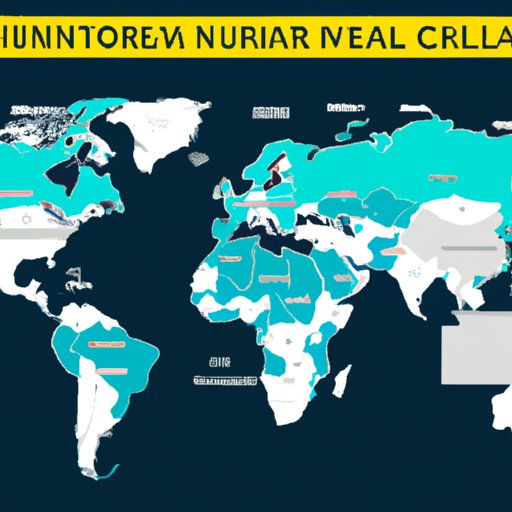Introduction
Understanding which countries have the most nuclear weapons is of utmost importance in today’s geopolitical climate. With tensions high and threats of nuclear war looming, it is crucial to stay informed about the global nuclear landscape. This article will explore the countries with the most nuclear weapons, the nations most concerning regarding nuclear proliferation, and the world’s nuclear capabilities
The List of Countries With the Most Nuclear Weapons: Who Has The Most?
Currently, the United States and Russia possess the vast majority of the world’s nuclear weapons. As of 2021, the United States has an estimated 5,550 nuclear warheads, while Russia has an estimated 6,255. Following shortly behind are China with approximately 350 warheads, France with about 290, and the United Kingdom with roughly 200.
It’s worth noting that while these figures show the total number of nuclear warheads that each country possesses, it’s important to recognize that stockpiles can vary significantly in terms of quality and delivery capabilities. The U.S. and Russia, for instance, account for over 90% of all nuclear warheads, which is why the two nations significantly influence global disarmament initiatives and related debates. One key takeaway is that the countries that possess a significant number of nuclear weapons hold significant power. These nations’ actions are critical to global security.
Nuclear Proliferation: Which Countries Pose the Greatest Threat?
North Korea and Iran are currently of the greatest concern regarding nuclear proliferation. North Korea has been actively developing its nuclear arsenal since the 1980s and has aggressively ramped up its efforts in recent years. The country has now conducted six nuclear tests since 2006. North Korea’s pursuit of nuclear weapons and its volatile political climate pose a significant threat to regional and global security.
Iran continues to develop its nuclear capabilities, despite significant concerns from the international community. While Iran has repeatedly stated that its nuclear program is for peaceful purposes, critics suggest that the country could be working towards a nuclear weapon. In 2015, Iran signed a deal with world powers agreeing to curb its nuclear program in exchange for lifting sanctions. However, in 2018, the United States withdrew from the agreement, casting doubt on the future of nuclear disarmament in the region and globally.
The Global Arms Race: Ranking Countries by Their Nuclear Arsenal
India and Pakistan have been ramping up their nuclear arsenals, with both nations reportedly possessing 150 or more warheads. The geopolitical tension between these two countries is significant. In February 2019, the two nations engaged in an aerial battle after Indian warplanes carried out a raid in Pakistan’s territory. In such an atmosphere of mutual distrust, a potential detonation of nuclear weapons could have catastrophic consequences.
Another country believed to possess nuclear weapons is Israel – although it has never officially confirmed the existence of nuclear weapons of its own. According to the International Campaign to Abolish Nuclear Weapons (ICAN), Israel has an estimated 90 warheads.
The Top 5 Nations With the Most Nuclear Power
While nuclear power capabilities don’t necessarily mean a country has more nuclear weapons, it is worth noting which countries have advanced nuclear power capabilities. According to the World Nuclear Association, the United States has the most nuclear power plants, with 93 reactors in operation, followed by France with 57 and China with 49. While nuclear power plays a role in the world’s clean energy future, it carries significant dangers, including nuclear meltdowns and radioactive contamination.
Nuclear Warfare: Which Countries Have The Upper Hand
It’s worth noting that even a small number of nuclear weapons can have catastrophic consequences. However, in terms of nuclear warheads, the United States and Russia have the ability to launch a devastating attack. According to the Federation of American Scientists, the United States currently has 800 deployed strategic nuclear warheads, while Russia has over twice as much with 1,600.
The consequences of nuclear war are tremendous and unimaginable, including widespread destruction and loss of life from nuclear explosions and radioactive fallout. Post-World War II, policymakers worldwide have prioritized preventing the use of nuclear weapons.
Assessing the World’s Nuclear Threats: A Comprehensive Review
The world currently faces significant challenges related to nuclear proliferation and disarmament. The Nuclear Non-Proliferation Treaty, aimed to prevent the acquisition of nuclear weapons and promote disarmament for all countries, has been in force since 1970, but efforts are slow. The UN is preoccupied with disarmament issues, and while it has been able to detect and prevent some countries from acquiring nuclear weapons, challenges remain.
The recent success of Iran developing nuclear capabilities will be of significant concern to the international community. The US and Russia have stalled on disarmament progress while North Korea continues to show off its nuclear capabilities. The world has had some significant success in reducing nuclear weapons worldwide. However, the recent challenges have highlighted the world’s inadequate ability to address nuclear weapons.
Understanding the Nuclear Capabilities of the World’s Major Powers
In addition to the countries discussed above, China and India have ramped up their nuclear capabilities in recent years. These nations’ rise is of concern to other nations. China has significantly increased investment in nuclear programs, and India continues to expand its nuclear power.
Russia’s nuclear arsenal is massive, and while the nation has reduced its nuclear arsenal, experts believe that it’s unlikely that Moscow will agree to limit its capabilities further. The US holds the largest arsenal of nuclear weapons but has also reduced the number of warheads significantly since the Cold War era.
Conclusion
Nuclear weapons remain one of the world’s most significant challenges. It is of utmost importance to understand the countries with the most nuclear weapons, those most concerning regarding nuclear proliferation, and the nations investing in new nuclear capabilities. The implications of nuclear disaster are catastrophic and long-lasting, which is why all nations must take the necessary steps to reduce the risks of nuclear war.
